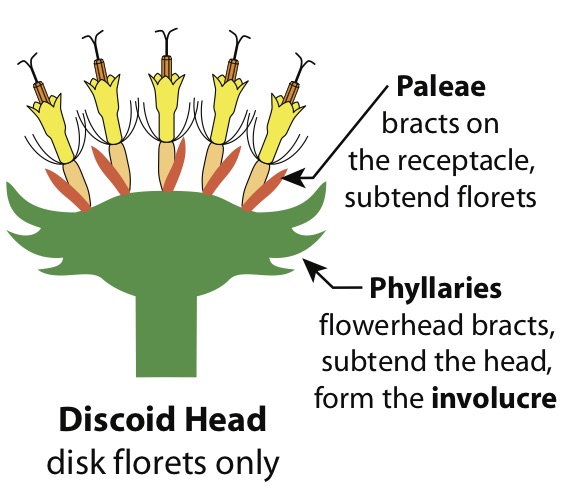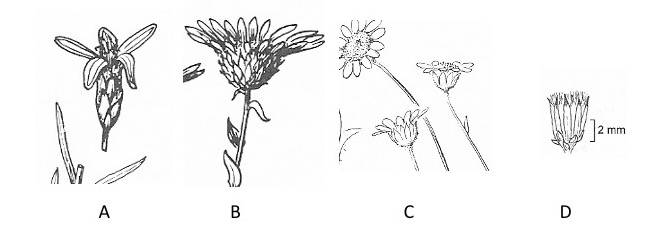The inflorescence
Head types
Heads of flowers may look very different depending on the type(s) of flowers attached to the receptacle.
A radiate head has two types of flowers: disk flowers in the center and ray flowers at the edge. The disk flowers are bisexual, but the ray flowers are typically pistillate or sterile. This is the head type seen commonly in daisies and sunflowers.
A liguliflorous head has only ligulate flowers.
A discoid head has only disk flowers.
A disciform head has disk flowers and marginal pistillate (or sterile) flowers with minute or missing rays. It looks very similar to discoid head.
A radiant head is a discoid head with the peripheral flowers (at the outer edge) having enlarged, often bilateral corollas
A two-page excerpt from Allen and Roberts (2013) shows head types and flower types in the Asteraceae.
The receptacle
Paleae on the receptacle
The receptacle may bear bristles or paleae between the flowers...or it may not. The term "palea", when used in the Asteraceae, refers to a scale like bract that subtends a single flower. "Paleae" is the plural form of "palea". Think of paleae as the leaves in whose axils the flowers were produced.
The diagram below shows a discoid head with paleae. Notice that a palea is not part of any flower and is not part of the involucre (a set of leaf-like bracts that subtend the entire head).

Occasionally, paleae are only found at the base of the outermost ring of flowers.
Receptacle shapes
Receptacle shape may be used to distinguish taxa in the Asteraceae. To look at the shape of the receptacle, you generally have to make a longitudinal section of the flower head. The receptacle may then be seen as being either flat, concave, convex, spheric, conical, or cylindrical.

The involucre
The involucre that subtends a head of flowers in the Asteraceae consists of a set of bracts called "phyllaries". These are usually green and leaf-like.
The involucre can be described based on...
- the shapes and characteristics of its phyllaries
- the arrangement of its phyllaries, and
- the shape of the entire involucre
Shapes and characteristics of phyllaries are described using the same terms we use to describe leaf shapes and characteristics.
The arrangement of phyllaries is described with respect to the number of whorls of phyllaries in the involucre. A whorl is refered to as a "series". Typical descriptions include both (1) the series of phyllaries in an involucre and (2) whether phyllaries in different series are the same size or not.
- "Phyllaries in one series" means that there is only one row or whorl of phyllaries. (They are usually all the same size.)
- "Phyllaries unequal, in 2-3 series" means that there are 2-3 whorls of phyllaries, and the phyllaries in at least one whorl are shorter than those in the other whorls.
- "Phyllaries graduated in 3-4 series" means that there are 3-4 whorls of phyllaries and that they gradually increase in size from the outermost to the innermost phyllaries.
Check your understanding:
Below are heads of flowers from four species in the Asteraceae.
